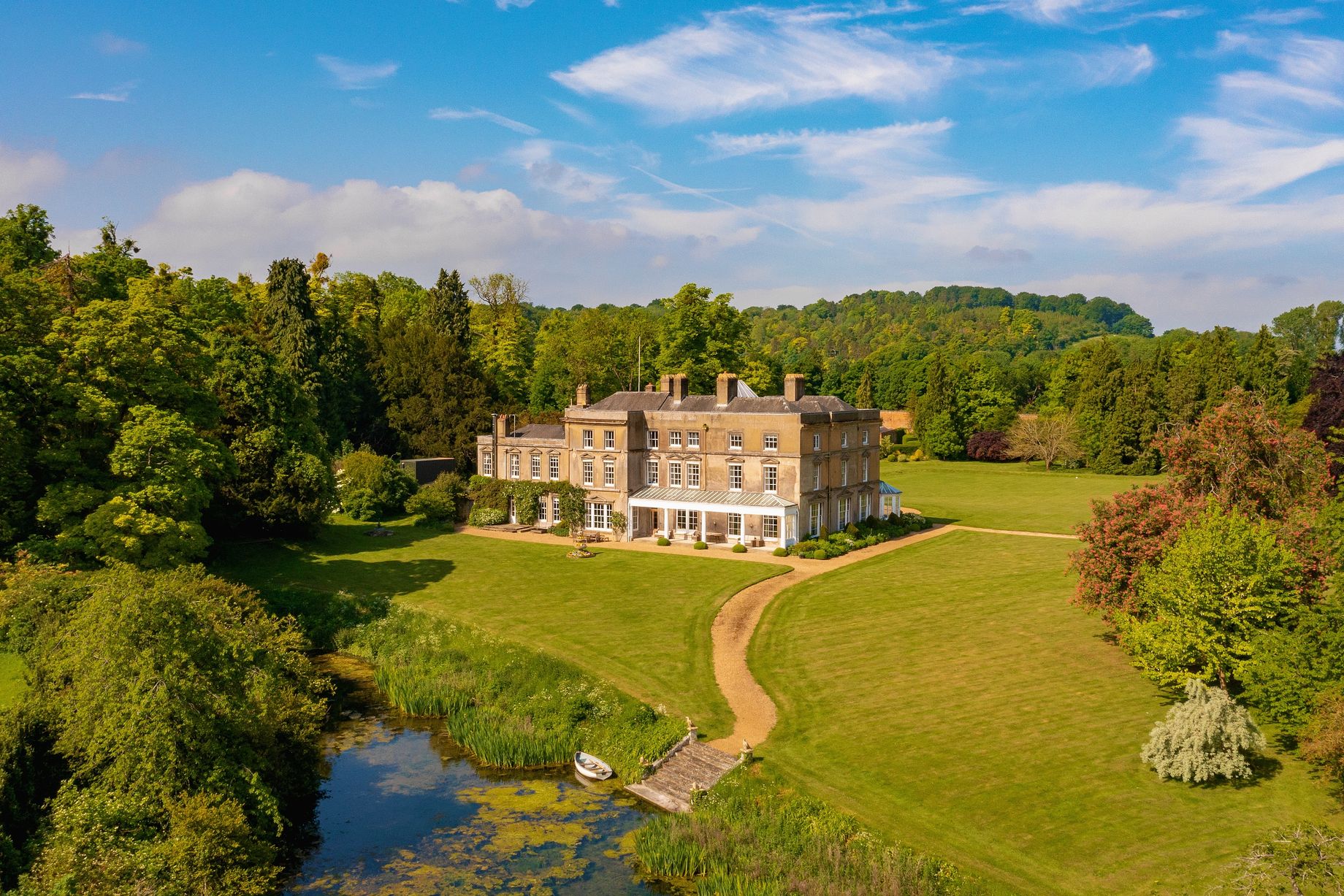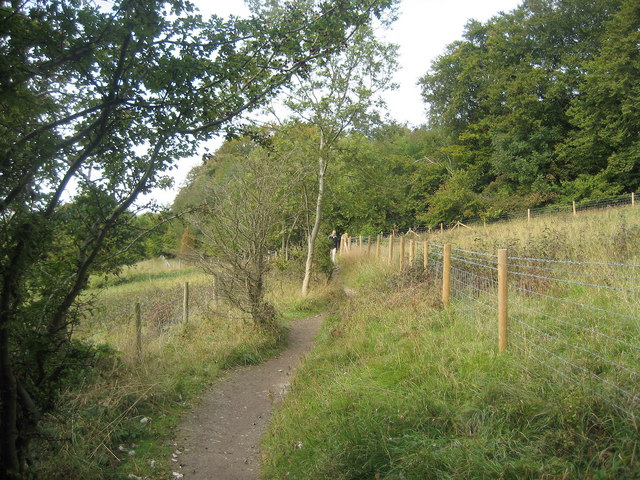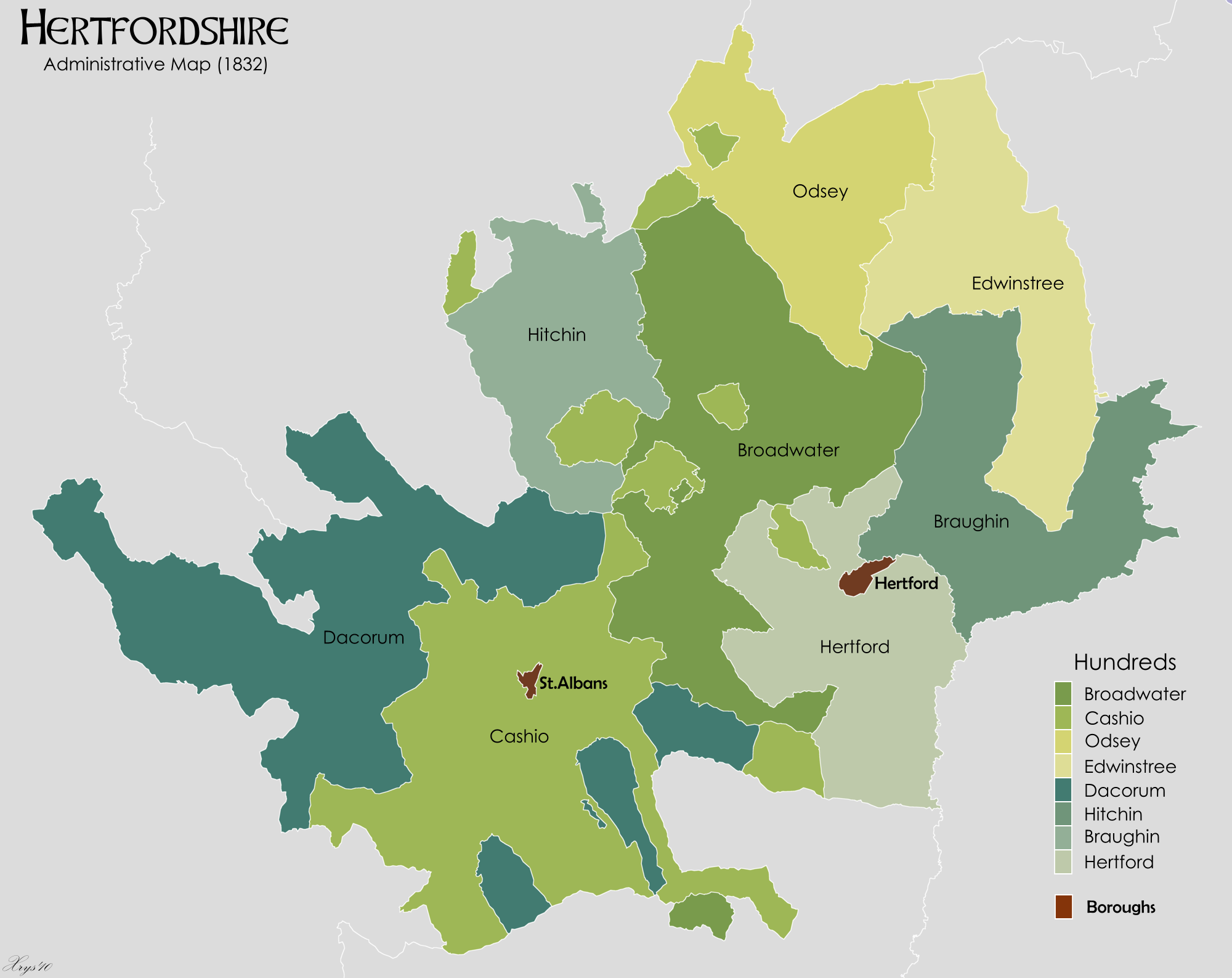|
Hexton
Hexton is a small village and civil parish in Hertfordshire, England, about west of Hitchin. This parish is a salient of Hertfordshire jutting northwards into Bedfordshire. The southern half of the parish is part of the chalky downs of the Chiltern Hills, which are covered with short turf and plantations of fir trees. The hills end abruptly and close to their foot lies the village of Hexton. It stands among grass fields and orchards at the beginning of a low plain, which, sloping gradually to the north, becomes merged in the large plain of southern Bedfordshire. The southern boundary of the parish is the grassy Icknield Way. Hexton formerly belonged to the half-hundred of Hitchin, but when it came into the possession of the abbots of St Albans Abbey it was probably added by them to their hundred of Cashio. Hexton was originally named Hehstanstuna, Hegestanestone (11th century); Hextenestona (14th century); Hextone (15th century), from Anglo-Saxon ''Heahstānes tūn''. M ... [...More Info...] [...Related Items...] OR: [Wikipedia] [Google] [Baidu] |
St Faith's Church, Hexton
Saint Faith's Church, Hexton is the Anglican parish church for the village of Hexton, Hertfordshire. The church is within the parish of Barton-le-Clay in the Diocese of St Albans. The church has been a Grade II* listed building since 1968. History The Parish Church of St Faith's, Hexton was originally built in 1108 and dedicated in 1114, it was then rebuilt with the original core in 1254 and dedicated to the French Virgin Martyr Saint Faith. The southern aisle was built before the northern aisle which was added in the 1633 renovation of the church. The existing red brick parts of the church were added later in the 1824 renovation which was carried out by Joseph Andrew de Lautour and his wife Caroline Young. De Lautour was the local landowner of Hexton Manor and descended from the senior line of the Dukes of Bouillon The Duchy of Bouillon (french: Duché de Bouillon) was a duchy comprising Bouillon and adjacent towns and villages in present-day Belgium. The state origina ... [...More Info...] [...Related Items...] OR: [Wikipedia] [Google] [Baidu] |
Hexton Manor
Hexton Manor is a country house in Hexton, Hertfordshire that has been home to the Lautour family, descendants of the Dukes of Bouillon and Major Sir Patrick Ashley Cooper. History The Manor of Hexton started as part of the estate of St Albans Abbey until the dissolution of the monasteries in 1541 at which point it was given away from the church. The estate was owned by seventeen different families although it ended up with the Poyntz family under Newdigate Poyntz. Hexton Manor started as a farmhouse in the 17th century, although was enlarged into a manor house in the 18th century. In 1820 the then owner, Joseph Andrew de Lautour and his wife Caroline Young de Lautour enlarged the house further. De Lautour inherited the property through his wife Caroline Young who was the daughter of William Young, the illegitimate child of Patrick Murray, 5th Lord Elibank who had owned the Hexton Estate priorly. The manor remained in the de Lautour family until it was purchased by George Ho ... [...More Info...] [...Related Items...] OR: [Wikipedia] [Google] [Baidu] |
Herts And Middlesex Wildlife Trust
Herts and Middlesex Wildlife Trust manages over 40 nature reserves covering nearly north of London, in Hertfordshire and the historic county of Middlesex, part of which is divided between the London boroughs of Barnet, Enfield, Harrow and Hillingdon. It has over 21,000 members, and is one of 46 Wildlife Trusts across the UK. It is a Registered Charity, with its Registered Office in St Albans, and had an income in the year to 31 March 2014 of over £1.5 million. The trust's activities include managing nature reserves, advising landowners on how to manage their land for wildlife, commenting on planning applications, advising planning authorities and campaigning to protect wildlife. The trust also encourages people to be active volunteers helping to maintain nature reserves. The first preparatory meeting of what was to become the trust was held on 16 November 1963, and the Hertfordshire & Middlesex Trust for Nature Conservation was incorporated on 9 October 1964. By 1970 ... [...More Info...] [...Related Items...] OR: [Wikipedia] [Google] [Baidu] |
Hexton Chalk Pit
Hexton Chalk Pit is a nature reserve in Hexton in North Hertfordshire, managed by the Herts and Middlesex Wildlife Trust. It is grassland with steep slopes and many chalk-loving plants such as horseshoe vetch, yellow-wort, milkwort and rockrose. There are five species of orchid and a large colony of chalkhill blue butterflies. The site has extensive views over the countryside. The reserve is on the left of the road signposted "Lilley" from Hexton. There is also access by a footpath, signposted "circular walk", from Barton Hill Road, close to the Icknield Way Path Icknield is a parliamentary ward, of the Luton district, in the town of Luton, Bedfordshire, England. The ward takes its name from the Icknield Way, a pre-Roman road which passes through Luton. Situated towards the northeast of Luton, the ward is .... References {{coord, 51.957017, -0.389706, type:landmark_region:GB, display=title Herts and Middlesex Wildlife Trust reserves North Hertfordshire District ... [...More Info...] [...Related Items...] OR: [Wikipedia] [Google] [Baidu] |
Patrick Ashley Cooper
Major Sir Patrick Ashley Cooper (18 November 1887 – 22 March 1961) was a British businessman who for more than two decades was governor of the Hudson's Bay Company and director of the Bank of England. He served as High Sheriff of the County of London and as High Sheriff of Hertfordshire. Early life and education Ashley Cooper was born in Aberdeen, the eldest son of Patrick Cooper, and Mary Cook of Ashley, Aberdeenshire. He was educated at Fettes College in Edinburgh before attending Trinity Hall, Cambridge, and Aberdeen University, studying law. Career War service In 1906, Ashley Cooper joined the Volunteer Corps. He was commissioned as a 2nd Lieutenant in the 1st Aberdeenshire division, 2nd Highland Brigade, of the Royal Field Artillery. In 1913, he joined the 7th London Brigade as a lieutenant. During the First World War, Ashley Cooper served in France with the Royal Field Artillery. He was wounded in 1915 and twice mentioned in dispatches, and was promoted to Major. He ... [...More Info...] [...Related Items...] OR: [Wikipedia] [Google] [Baidu] |
Liberty Of St Albans
The Liberty of St Albans (also known as the ''Hundred of Albanestou'' or ''Cashio'') was a liberty situated within Hertfordshire, but enjoying the powers of an independent county. It was originally associated with the abbey of St Albans, and later with the borough corporation. It was absorbed by Hertfordshire in 1874. It was also known as the Hundred of Cashio. The origins of the liberty are unclear, but the abbots of St Albans claimed that the privileges had first been granted by King Offa of Mercia, who founded the abbey in 793. The Liberty appears to have been formed from parts of the Dioceses of London and Lincoln. At the time of the Domesday Book the liberty was known as ''Albanestou''. The boundaries of the area expanded over time, including at times parts of Buckinghamshire. Exactly what powers the liberty possessed previous to the twelfth century are not known. Edward I gave the abbot of St Albans palatine powers equal to those enjoyed by the bishops of Durham and E ... [...More Info...] [...Related Items...] OR: [Wikipedia] [Google] [Baidu] |
North Hertfordshire
North Hertfordshire is a Non-metropolitan district, local government district in Hertfordshire, England. Its council is based in Letchworth. The district was formed on 1 April 1974 by the amalgamation of the Urban district (Great Britain and Ireland), urban districts of Baldock, Hitchin, Letchworth, and Royston, Hertfordshire, Royston and the Hitchin Rural District. From eastward clockwise, it borders the districts of East Hertfordshire, Stevenage, Welwyn Hatfield, City and District of St Albans, St Albans in Hertfordshire, Central Bedfordshire, Luton, Central Bedfordshire again, and South Cambridgeshire. Towns * Baldock * Hitchin * Letchworth * Royston, Hertfordshire, Royston * Most of the Great Ashby development north east of Stevenage falls within North Hertfordshire. Parishes and unparished areas North Hertfordshire contains following civil parishes and unparished areas. Changes since 1974 resulting in creation or abolition of parishes are noted, but not boundary changes b ... [...More Info...] [...Related Items...] OR: [Wikipedia] [Google] [Baidu] |
Hertfordshire
Hertfordshire ( or ; often abbreviated Herts) is one of the home counties in southern England. It borders Bedfordshire and Cambridgeshire to the north, Essex to the east, Greater London to the south, and Buckinghamshire to the west. For government statistical purposes, it forms part of the East of England region. Hertfordshire covers . It derives its name – via the name of the county town of Hertford – from a hart (stag) and a ford, as represented on the county's coat of arms and on the flag. Hertfordshire County Council is based in Hertford, once the main market town and the current county town. The largest settlement is Watford. Since 1903 Letchworth has served as the prototype garden city; Stevenage became the first town to expand under post-war Britain's New Towns Act of 1946. In 2013 Hertfordshire had a population of about 1,140,700, with Hemel Hempstead, Stevenage, Watford and St Albans (the county's only ''city'') each having between 50,000 and 100,000 r ... [...More Info...] [...Related Items...] OR: [Wikipedia] [Google] [Baidu] |
Chiltern Hills
The Chiltern Hills is a chalk escarpment in England. The area, northwest of London, covers stretching from Goring-on-Thames in the southwest to Hitchin in the northeast - across Oxfordshire, Buckinghamshire, Hertfordshire, and Bedfordshire. The hills are at their widest. In 1965 almost half of the Chiltern Hills was designated as an Area of Outstanding Natural Beauty (AONB). The northwest boundary is clearly defined by the escarpment. The dip slope is by definition more gradual, and merges with the landscape to the southeast. The southwest endpoint is the River Thames. The hills decline slowly in prominence in northeast Bedfordshire.The Changing Landscape of the Chilterns Chilterns AoNB, Accessed 19 February 2012 < ...
|
Cassivelaunus
Cassivellaunus was a historical British military leader who led the defence against Julius Caesar's second expedition to Britain in 54 BC. He led an alliance of tribes against Roman forces, but eventually surrendered after his location was revealed to Julius Caesar by defeated Britons. Cassivellaunus made an impact on the British consciousness. He appears in British legend as Cassibelanus, one of Geoffrey of Monmouth's kings of the Britons, and in the '' Mabinogion'', the ''Brut y Brenhinedd'' and the Welsh Triads as Caswallawn, son of Beli Mawr. Name The Common Brittonic personal name ''Cassiuellaunos'' stems from the word ''uellaunos'' ('chief, commandant'). The meaning of the prefix ''cassi-'' has been debated, but it possibly signifies 'tin, bronze'. Cassivellaunus may thus been translated as 'Chief-of-Tin', that is to say 'the inflexible'. The personal name ''Ver-cassivellaunus'' ('True-Chief-of-Tin') is related. History Cassivellaunus appears in Julius Caesar's ''C ... [...More Info...] [...Related Items...] OR: [Wikipedia] [Google] [Baidu] |
United Kingdom Census 2001
A nationwide census, known as Census 2001, was conducted in the United Kingdom on Sunday, 29 April 2001. This was the 20th UK census and recorded a resident population of 58,789,194. The 2001 UK census was organised by the Office for National Statistics (ONS) in England and Wales, the General Register Office for Scotland (GROS) and the Northern Ireland Statistics and Research Agency (NISRA). Detailed results by region, council area, ward and output area are available from their respective websites. Organisation Similar to previous UK censuses, the 2001 census was organised by the three statistical agencies, ONS, GROS, and NISRA, and coordinated at the national level by the Office for National Statistics. The Orders in Council to conduct the census, specifying the people and information to be included in the census, were made under the authority of the Census Act 1920 in Great Britain, and the Census Act (Northern Ireland) 1969 in Northern Ireland. In England and Wales these re ... [...More Info...] [...Related Items...] OR: [Wikipedia] [Google] [Baidu] |
Scheduled Ancient Monument
In the United Kingdom, a scheduled monument is a nationally important archaeological site or historic building, given protection against unauthorised change. The various pieces of legislation that legally protect heritage assets from damage and destruction are grouped under the term "designation." The protection provided to scheduled monuments is given under the Ancient Monuments and Archaeological Areas Act 1979, which is a different law from that used for listed buildings (which fall within the town and country planning system). A heritage asset is a part of the historic environment that is valued because of its historic, archaeological, architectural or artistic interest. Only some of these are judged to be important enough to have extra legal protection through designation. There are about 20,000 scheduled monuments in England representing about 37,000 heritage assets. Of the tens of thousands of scheduled monuments in the UK, most are inconspicuous archaeological sites, but ... [...More Info...] [...Related Items...] OR: [Wikipedia] [Google] [Baidu] |






